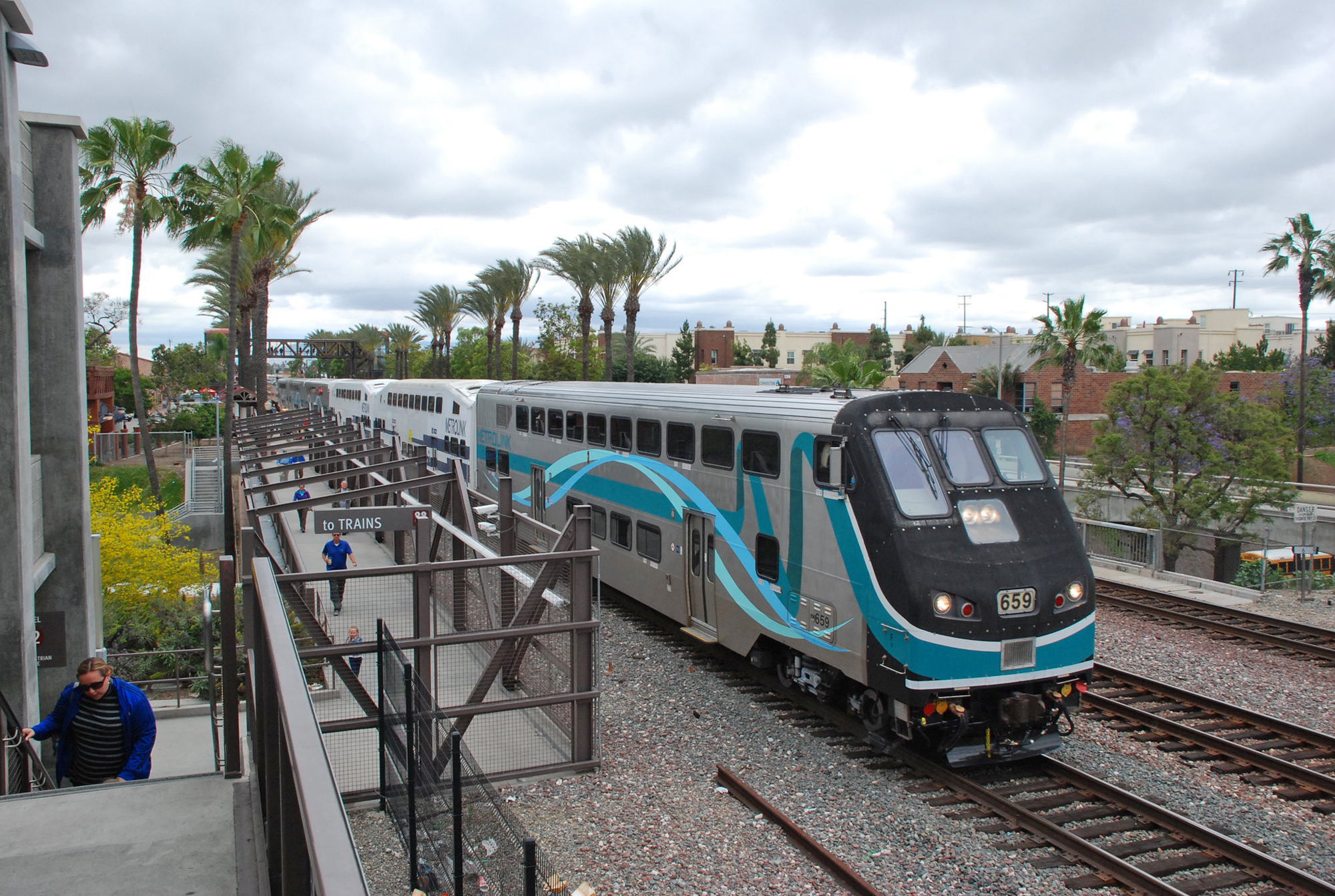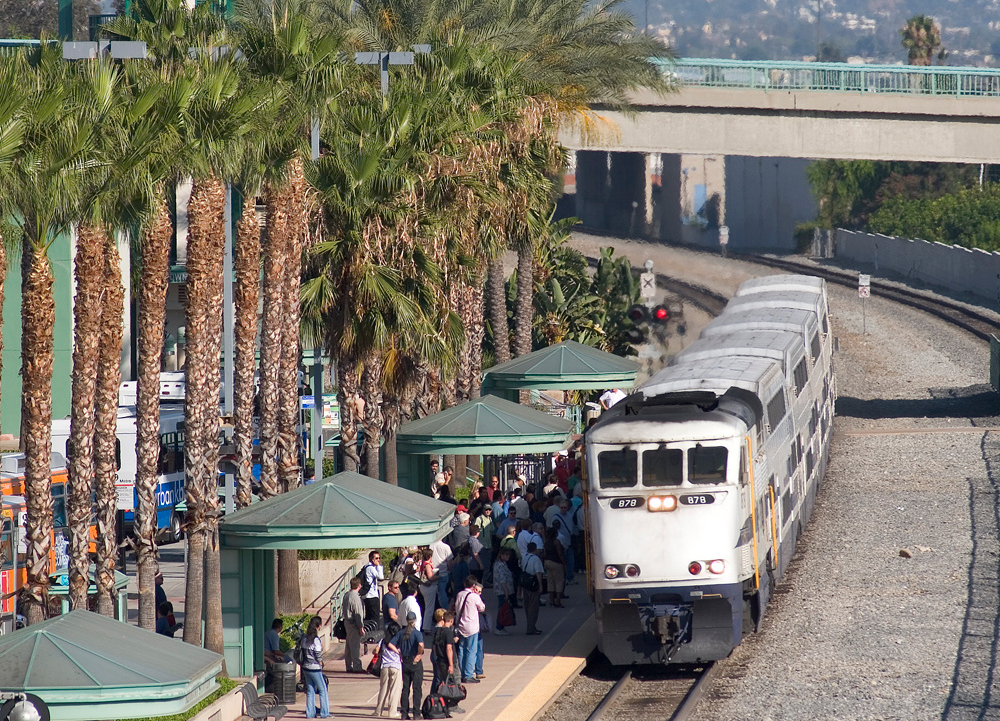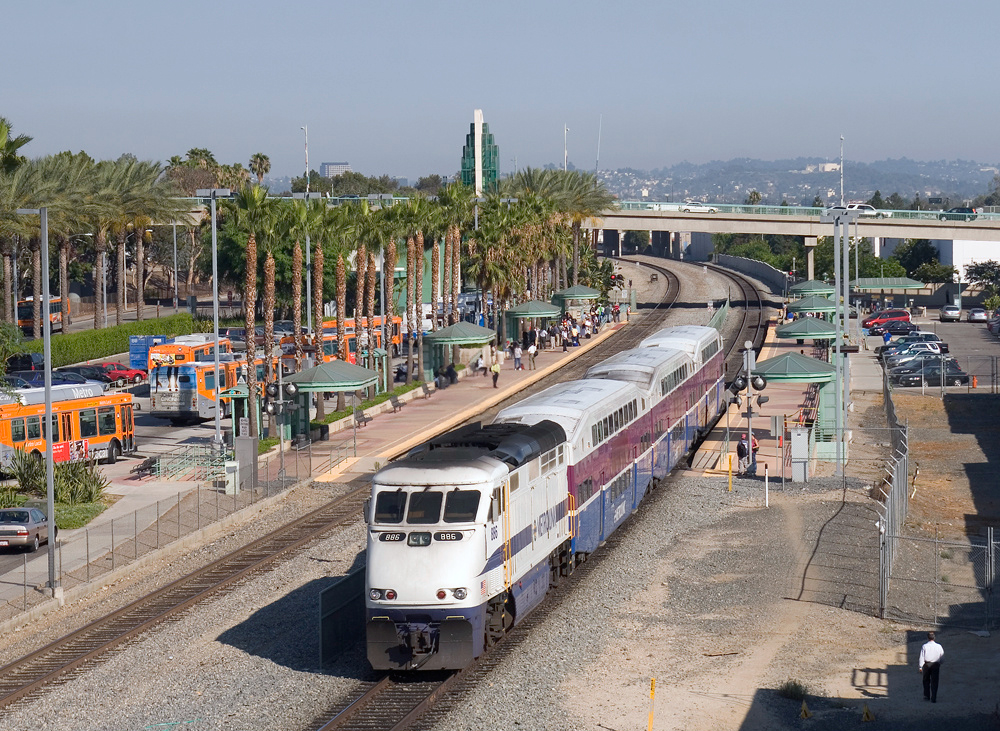Metrolink: Serving SoCal Since 1992
Published: August 1, 2024
By: Adam Burns
Metrolink is Southern California's commuter rail system, serving a vital role in connecting six counties—Ventura, Los Angeles, San Bernardino, Riverside, Orange, and San Diego.
It boasts 545.6 miles of track with 69 stations along eight lines, including the Antelope Valley Line, which runs from Lancaster to Los Angeles. In 2023, the system boasted 4,861,000 rides.
This comprehensive guide will provide an overview of Metrolink's history, current operations, and practical tips for travelers to maximize their experience on this extensive rail network.
 Metrolink cab car #659 leads train #663 out of the Fullerton station on May 6, 2017. Doug Kroll photo.
Metrolink cab car #659 leads train #663 out of the Fullerton station on May 6, 2017. Doug Kroll photo.Inception and Development: Early 1990s
The emergence of Metrolink was primarily driven by the need to alleviate traffic congestion and provide reliable public transit options for the sprawling and densely populated region of Southern California.
Discussions about a regional rail network commenced in the late 1980s, leading to the formation of the Southern California Regional Rail Authority (SCRRA) in 1991. This joint powers authority comprised transportation agencies from Los Angeles, Orange, Riverside, San Bernardino, and Ventura counties.
In October 1990, the member agencies of what would become SCRRA acquired 175 miles of track, yards, stations, and other property from Southern Pacific for $450 million.
That year the agencies also acquired Los Angeles Union Station from Union Pacific for $17 million. Metrolink began operations on October 26, 1992 under contract with Amtrak to operate the Ventura, Santa Clarita (now Antelope Valley), and San Bernardino Lines.
In 1993, service expanded to include the Riverside Line and the following year the Orange County Line was conveyed from Amtrak branding to Metrolink.
Over the years, the system has expanded further adding more lines, stations, and services to accommodate the growing demand for efficient public transportation.
Expansion and Modernization: 2000s-Present
Since its inception, Metrolink has continuously adapted to meet the diverse needs of its passengers. Key milestones include the extension of service to Riverside, Orange, and San Diego counties.
Additionally, significant investments in safety and infrastructure enhancements have been made, such as Positive Train Control (PTC) technology, which improves safety by monitoring and controlling train movements.
Present Day Operations
Metrolink operates eight lines that span over 500 route miles, connecting 62 stations across Southern California:
1. **Antelope Valley Line**: Connecting Los Angeles Union Station to Lancaster.
2. **Ventura County Line**: Linking Los Angeles Union Station to East Ventura.
3. **San Bernardino Line**: Running from Los Angeles Union Station to San Bernardino and Redlands.
4. **Orange County Line**: Downtown Los Angeles to Oceanside.
5. **Riverside Line**: Los Angeles Union Station to Riverside-Downtown.
6. **91/Perris Valley Line**: Los Angeles Union Station to Perris via Riverside.
7. **Inland Empire-Orange County Line**: San Bernardino to Oceanside via Orange County.
8. **Arrow Line**: This route runs east from downtown San Bernardino to the University of Redlands (Redlands).
Key Stations
Metrolink’s network converges at several major stations:
- **Los Angeles Union Station:** This historic hub is the primary terminal for most Metrolink lines, offering connections to Amtrak, Metro Rail, and bus services.
- **Oceanside Transit Center:** A significant stop on the Orange County and Inland Empire-Orange County Lines, connecting to North County Transit District’s COASTER and SPRINTER services.
- **Riverside-Downtown:** Serving as a major transit hub for the Riverside Line and 91/Perris Valley Line.
- **San Bernardino-Downtown:** Another key interchange, providing connectivity to the San Bernardino Transit Center with access to bus and future light rail services.
Ticketing and Fares
Metrolink offers various ticketing options tailored to different travel needs:
- **One-Way Tickets:** Best for occasional travelers.
- **Round-Trip Tickets:** Offering a small discount for same-day travel to and from your destination.
- **7-Day Passes:** Ideal for frequent short-term travelers.
- **Monthly Passes:** Offering unlimited travel between selected zones for a calendar month, perfect for daily commuters.
- **Weekend Day Passes:** Allowing unlimited travel across the entire network on weekends for a flat rate.
Tickets can be purchased at station ticket vending machines, via the Metrolink mobile app, or online through the Metrolink website.
 Metrolink F59PHI #878 has an outbound commuter run as the train eases into the station at Burbank, California on August 2, 2007. Wade Massie photo.
Metrolink F59PHI #878 has an outbound commuter run as the train eases into the station at Burbank, California on August 2, 2007. Wade Massie photo.Service Schedules
Metrolink trains operate on fixed schedules that vary by line. Peak service primarily aligns with morning and evening commuter rush hours, while midday, evening, and weekend services see reduced frequency. Travelers are advised to consult the latest schedules available on Metrolink’s website or mobile app to plan their journeys.
Navigating the Metrolink System: Practical Tips for Travelers
1. **Planning Your Trip:**
- Identify your starting station and desired destination.
- Use Metrolink’s website or mobile app to access timetables and service updates.
- Ensure you have the appropriate ticket or pass for your trip.
2. **Purchasing Tickets:**
- Buy tickets from vending machines at stations, the Metrolink mobile app, or the Metrolink website.
- Validate your ticket at the station if necessary.
3. **Boarding and Riding:**
- Check the electronic displays or listen for announcements to confirm your train’s platform and departure time.
- Board the appropriate train car—look for designations for quiet cars if you prefer a quieter ride.
- Keep your ticket handy, as conductors will check for fare compliance during your journey.
4. **Transfers and Connections:**
- Some journeys may require transfers, particularly if traveling outside peak hours. Plan extra time for such transfers and seek assistance from Metrolink staff if needed.
- Metrolink’s connections with other transit services, such as Amtrak, Metro Rail, and local bus services, make it easy to reach your final destination.
5. **Accessibility:**
- Metrolink is committed to accessibility, with ADA-compliant stations and trains.
- Elevators, ramps, and designated seating areas are available for passengers with disabilities.
6. **Bicycles:**
- Bikes are welcome on Metrolink trains, but certain restrictions apply during peak hours.
- Bike cars are available on several lines, equipped with bike racks and additional space.
7. **Safety and Etiquette:**
- Follow onboard rules, such as keeping noise to a minimum in quiet cars.
- Stand clear of the platform edge while waiting for your train.
- In case of emergencies, locate the train crew or contact transit police.
8. **Amenities and Services:**
- Most Metrolink trains offer power outlets, and restrooms.
- Onboard announcements and digital displays provide real-time information about upcoming stops and service changes.
Exploring Southern California with Metrolink
Using Metrolink as your primary mode of transportation opens up a myriad of opportunities to explore Southern California’s diverse attractions. Here are some must-visit destinations easily accessible by Metrolink:
1. **Los Angeles Union Station (L.A. Union Station):**
- As the main hub, L.A. Union Station offers proximity to various cultural and historical landmarks, including Olvera Street, Little Tokyo, Chinatown, and the Arts District.
2. **Oceanside Transit Center:**
- For beach lovers, Oceanside is a prime destination with beautiful sandy shores, a historic pier, and vibrant local dining options. The transit center also connects you to San Diego’s coastal attractions.
3. **San Bernardino-Downtown:**
- Nestled at the base of the San Bernardino Mountains, this destination offers access to hiking trails, historical sites, and local festivals.
4. **Fullerton Transportation Center:**
- Located in the heart of Orange County, Fullerton boasts a lively downtown area, cultural venues, and dining options. It is also home to the renowned Muckenthaler Cultural Center.
5. **Riverside-Downtown:**
- Explore the historic Mission Inn, museums, and a bustling arts scene. Riverside’s scenic parks and local festivals add to its charm.
6. **Lancaster (Antelope Valley Line):**
- A gateway to the Antelope Valley, Lancaster offers access to the stunning Antelope Valley California Poppy Reserve, showcasing vibrant wildflower blooms in the spring.
7. **Anaheim (Orange County Line):**
- A popular destination for visitors to Disneyland Resort and nearby attractions like Anaheim GardenWalk and the vibrant Anaheim Packing District.
 Metrolink F59PHI #886 has train #910 returning to downtown Los Angeles as it slows for a brief station stop in Burbank on August 2, 2007. Wade Massie photo.
Metrolink F59PHI #886 has train #910 returning to downtown Los Angeles as it slows for a brief station stop in Burbank on August 2, 2007. Wade Massie photo.Conclusion
Metrolink has evolved into a crucial component of Southern California’s transportation infrastructure, offering efficient, reliable, and environmentally friendly commuter rail services.
With extensive coverage, convenient ticketing options, and various amenities, Metrolink provides a hassle-free travel experience for both daily commuters and leisure travelers.
Whether you are commuting to work, exploring the cultural riches of Los Angeles, or venturing out to the picturesque suburbs and coastal towns, the system offers a convenient and sustainable way to experience Southern California.
By understanding the network, planning your trip effectively, and utilizing the services available, you can make the most of your journey on Metrolink. Safe travels!
Recent Articles
-
Virginia Wine Tasting Train Rides
Jul 07, 25 10:45 PM
Wine tasting trains in Virginia provide just that—a unique experience that marries the romance of rail travel with the sensory delights of wine exploration. -
Vermont Wine Tasting Train Rides
Jul 07, 25 10:39 PM
Known for its stunning green mountains, charming small towns, and burgeoning wine industry, Vermont offers a unique experience that seamlessly blends all these elements: wine tasting train rides. -
Indiana's Whiskey Train Rides
Jul 07, 25 10:31 PM
Whether you're a local resident or a traveler looking to explore Indiana from a unique perspective, hopping on a whiskey train ride is a journey worth considering.


